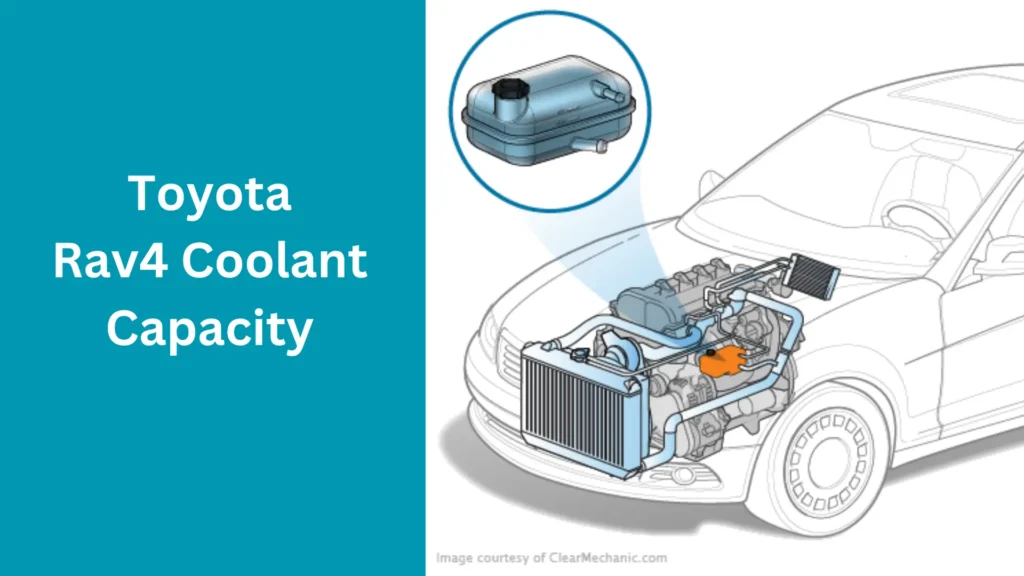Your RAV4 has various fluids, each serving a special role. Among them, coolant stands out as crucial. It prevents your RAV4 engine from overheating, which could otherwise cause it to stop working. Keeping an eye on the coolant levels and replacing them regularly is vital for the smooth functioning of your vehicle.
In this article, I’ll explain why coolant is so important for your engine and guide you on how frequently you should replace it. Additionally, I’ll detail the specific types of coolant suitable for different RAV4 models to ensure optimal performance and longevity for your vehicle. In this guide, we’ll discuss Toyota Rav4 coolant capacity.
Understanding Toyota Rav4 Engine Coolant
Engine coolant, often referred to as antifreeze, plays a crucial role in keeping your car running smoothly. While antifreeze and coolant are often used interchangeably, they’re slightly different.
Antifreeze is the main component of coolant and is typically made from ethylene glycol or propylene glycol. Coolant, on the other hand, is a mixture of antifreeze and water, usually in a 50-50 ratio. However, in extremely cold climates, some vehicles may require a different ratio, such as 70% antifreeze and 30% water, to prevent freezing.
Coolant serves multiple purposes beyond just preventing freezing and overheating. It helps lubricate the engine’s moving parts, protecting components like the head gasket, water pump, engine block, and cylinder head from damage. Additionally, it prevents corrosion, ensuring your engine stays in good condition.
The coolant works by transferring heat away from the engine, keeping it at an optimal temperature. It circulates through a closed cooling system, traveling from the engine to the radiator and back again. This continuous cycle helps regulate the engine’s temperature, ensuring it operates efficiently and safely. So, maintaining the right coolant mixture is essential for your vehicle’s health and performance.
Checking Your RAV4’s Coolant Level
Ensuring your RAV4 has enough coolant is crucial to prevent engine damage. If the temperature gauge starts climbing into the “H” zone or the red zone, it’s a sign that there’s not enough coolant. Letting it reach that point can lead to costly repairs or even engine destruction.
To avoid such issues, it’s essential to check your RAV4’s coolant level regularly. You can find the coolant reservoir easily—it’s a large white container on the left side of the engine bay, clearly labeled.
However, a word of caution: never open the reservoir or radiator cap if the engine is hot. The coolant is pressurized and extremely hot, posing a risk of severe burns. Always wait for the engine to cool down before attempting to check or refill the coolant.
Here’s a simple guide to checking your RAV4’s coolant level safely:
- Place your RAV4 on a level ground and activate the parking brake.
- Shut down the engine and let it cool off.
- Open the hood, but avoid touching the radiator, hoses, or engine—they can be very hot.
- Locate the coolant reservoir on the left side of the engine compartment.
- Check the side of the reservoir to see the coolant level. If it’s dirty, wipe it clean for a clear view.
- Look for lines on the reservoir indicating “FULL” and “LOW.” If the coolant level falls between these lines while the engine is cold, it’s sufficient, and you don’t need to add more.
- If the coolant is below the “LOW” line, you’ll need to add more fluid. Remember to recheck the level periodically. Persistent drops may indicate a leak that needs fixing.
By following these steps, you can ensure your RAV4 stays properly cooled and protected from overheating, prolonging its lifespan and saving you from costly repairs.
How Often to Change Coolant?
Changing your RAV4’s coolant regularly is crucial for maintaining its performance and preventing engine damage. While the exact frequency may vary depending on factors like driving conditions and climate, it’s generally recommended to change the coolant every two to five years or every 30,000 to 50,000 miles.
However, it’s essential to consult your vehicle’s owner’s manual for specific recommendations tailored to your RAV4 model. Some newer vehicles may have extended coolant life, while others may require more frequent changes.
Additionally, if you notice any signs of coolant leakage, such as low coolant levels or coolant stains under your vehicle, it’s important to address the issue promptly and check the coolant more frequently.
Regular coolant changes help ensure your RAV4’s engine stays cool, preventing overheating and costly repairs down the road.
You should also check: Toyota Rav4 Engine Specs and Performance
Selecting the Right Coolant for Your RAV4
Choosing the correct coolant type for your RAV4 is essential to ensure optimal performance and longevity of your vehicle’s engine. It’s best to follow the manufacturer’s recommendations, which can vary depending on the model and year of your RAV4.
For RAV4 Gas Models:
- For models from 2004 to 2023, it’s recommended to use “Toyota Super Long Life Coolant,” which is a mixture of 50% coolant and 50% deionized water.
- For models from 2000 to 2003, a 50% coolant solution is advised for protection in temperatures as low as -35°C (-31°F). A 60% solution is recommended for even colder temperatures, down to about -50°C (-58°F). Avoid using more than a 70% solution for better coolant performance.
- For models from 1996 to 1999, it’s suggested to use “Toyota Long Life Coolant” or an equivalent with ethylene-glycol type coolant. Avoid alcohol-type antifreeze or plain water alone. A 50% solution protects down to approximately -35°C (-31°F).
For RAV4 Hybrid Models:
- For models from 2016 to 2023, “Toyota Super Long Life Coolant” is recommended, with the same 50% coolant and 50% deionized water mixture.
For RAV4 Prime Models:
- For models from 2021 to 2023, the recommendation is also “Toyota Super Long Life Coolant,” with the same 50% coolant and 50% deionized water mixture.
Following these recommendations ensures that your RAV4’s engine is properly protected against freezing and overheating, allowing for smooth and reliable operation in various weather conditions. Always adhere to the manufacturer’s guidelines to maintain your vehicle’s performance and durability.
Understanding Coolant Capacity for Your RAV4
Ensuring you use the correct amount of coolant in your RAV4 is crucial for its proper functioning. If you put too little coolant in, known as underfilling, it can lead to serious consequences such as engine overheating, lack of lubrication for vital components, and the introduction of air into the system, which can cause further damage.
On the other hand, overfilling the system can also lead to problems. Excess coolant can spill onto the engine and other components, potentially causing damage to electronics and creating leaks due to excessive pressure.
To avoid these issues, it’s essential to fill the coolant tank just below the “FULL” line. Here are the total coolant capacities for different RAV4 models, based on information from Toyota:
For RAV4 Gas Models:
- For models from 2000 to 2023:
- Without engine oil cooler: 7.3 qt. (6.9 L, 6.1 Imp. qt.)
- With engine oil cooler: 7.4 qt. (7.0 L, 6.2 Imp. qt.)
- For models from 1996 to 1999:
- Manual transmission: 8.0 qt. (8.5 L, 7.0 Imp. qt.)
- Automatic transmission: 7.7 qt. (8.1 L, 6.8 Imp. qt.)
For RAV4 Hybrid Models:
- For models from 2022 to 2023:
- Gasoline engine: 6.4 qt. (6.1 L, 5.4 Imp. qt.)
- Power control unit: 1.7 qt. (1.6 L, 1.4 Imp. qt.)
- For models from 2019 to 2021:
- Gasoline engine: 7.1 qt. (6.7 L, 5.9 Imp. qt.)
- Power control unit: 2.1 qt. (2.0 L, 1.8 Imp. qt.)
- For models from 2016 to 2018:
- Gasoline engine: 7.9 qt. (7.5 L, 6.6 Imp. qt.)
- Power control unit: 1.6 qt. (1.5 L, 1.3 Imp. qt.)
For RAV4 Prime Models:
- For models from 2021 to 2023:
- Gasoline engine: 8.7 qt. (8.2 L, 7.2 Imp. qt.)
- Power control unit: 2.1 qt. (2.0 L, 1.8 Imp. qt.)
By understanding these capacities and ensuring you fill the coolant to the appropriate level, you can help maintain your RAV4’s engine health and prevent potential issues down the road.
Common Coolant Problems
While coolant is essential for your vehicle’s engine health, several problems can arise if it’s not properly maintained or if issues occur with the cooling system. Here are some common coolant problems:
- Low Coolant Level: If the coolant level is too low, it can lead to engine overheating, which may cause serious damage if not addressed promptly. Low coolant levels can result from leaks in the cooling system or improper filling during maintenance.
- Coolant Leaks: Leaks in the cooling system can occur due to damaged hoses, radiator cracks, or a faulty water pump. These leaks can lead to a loss of coolant, causing the engine to overheat and potentially resulting in engine damage if left unchecked.
- Contamination: Coolant can become contaminated over time, leading to reduced effectiveness. Contamination can occur due to mixing different types of coolant, which can result in chemical reactions that degrade the coolant’s properties. Additionally, contaminants such as rust, dirt, or oil can enter the cooling system, affecting its performance.
- Coolant Dilution: In some cases, other fluids such as oil or fuel may mix with the coolant, diluting its effectiveness. This can happen due to leaks or internal engine issues, and it can compromise the coolant’s ability to regulate engine temperature.
- Coolant Discoloration: Over time, coolant may change color due to contamination or degradation. Discolored coolant may indicate the presence of contaminants or chemical breakdown, signaling the need for coolant replacement.
- Coolant Foaming: Foaming or bubbling coolant can indicate air pockets in the system or the presence of combustion gases due to a leaking head gasket.
- Coolant Odor: A sweet or unusual odor coming from the engine bay may indicate coolant leaks or overheating. Identifying and fixing the source of the odor is important to prevent further coolant loss or engine damage.
Regular inspection and maintenance of the cooling system can help prevent these common coolant problems, ensuring your vehicle’s engine stays cool and protected. If you notice any signs of coolant problems, such as leaks, discoloration, or unusual odors, it’s essential to address them promptly to prevent further damage and ensure optimal engine performance.
Conclusion
In conclusion, understanding the coolant capacity specific to your Toyota RAV4 model is essential for maintaining optimal engine performance and preventing potential problems like overheating or damage. By adhering to the recommended coolant levels provided by Toyota, you can ensure proper engine cooling and longevity for your vehicle, keeping it running smoothly for years to come.

